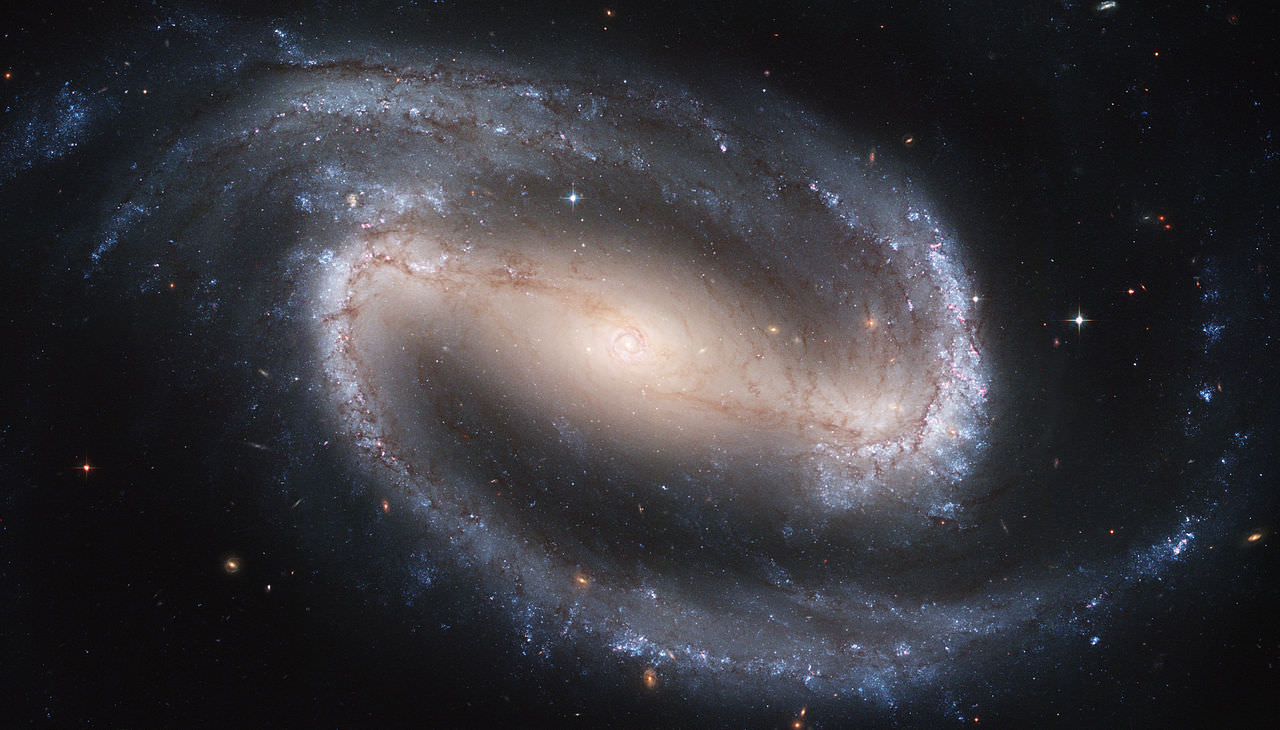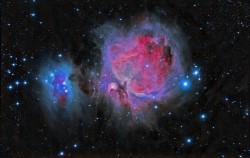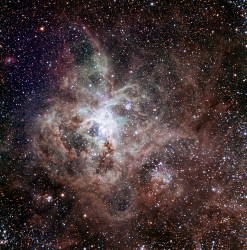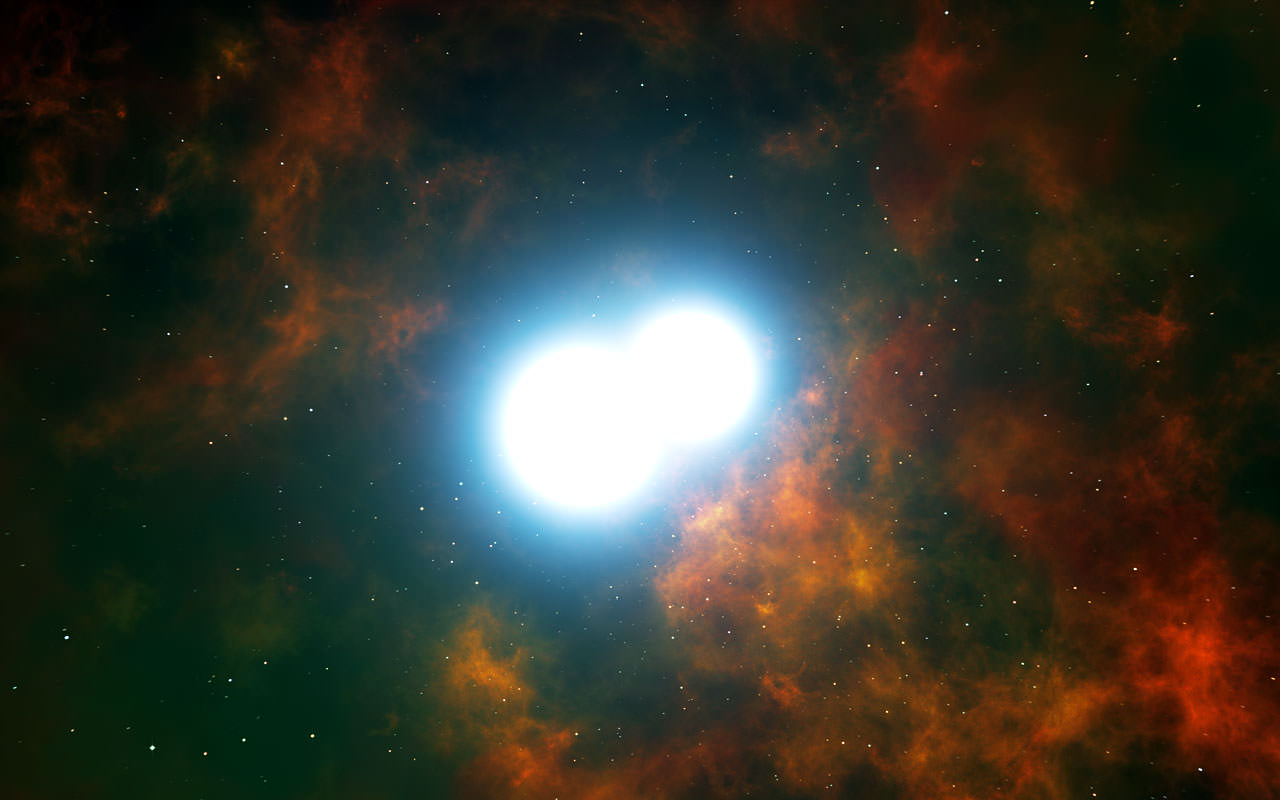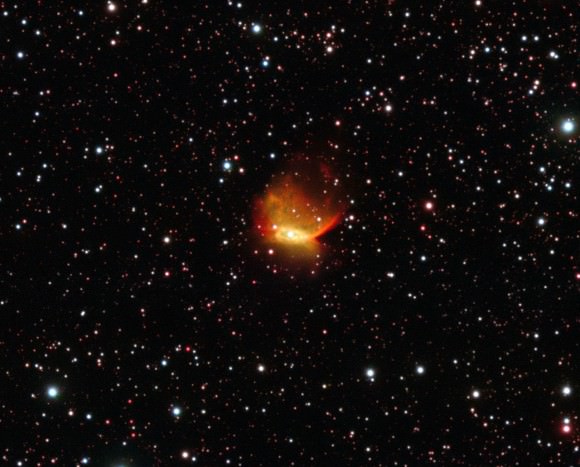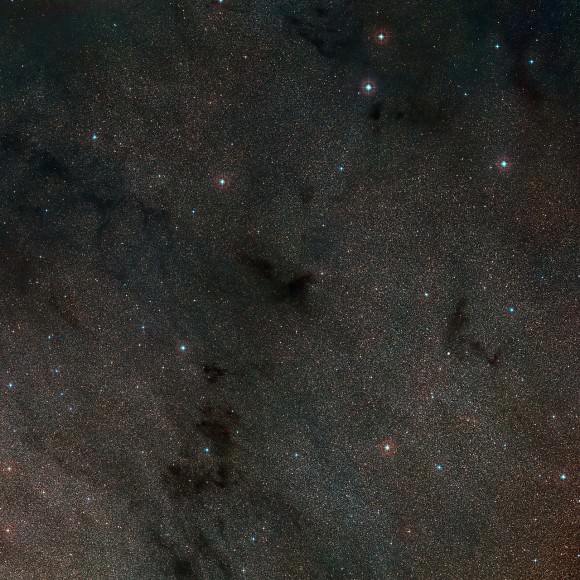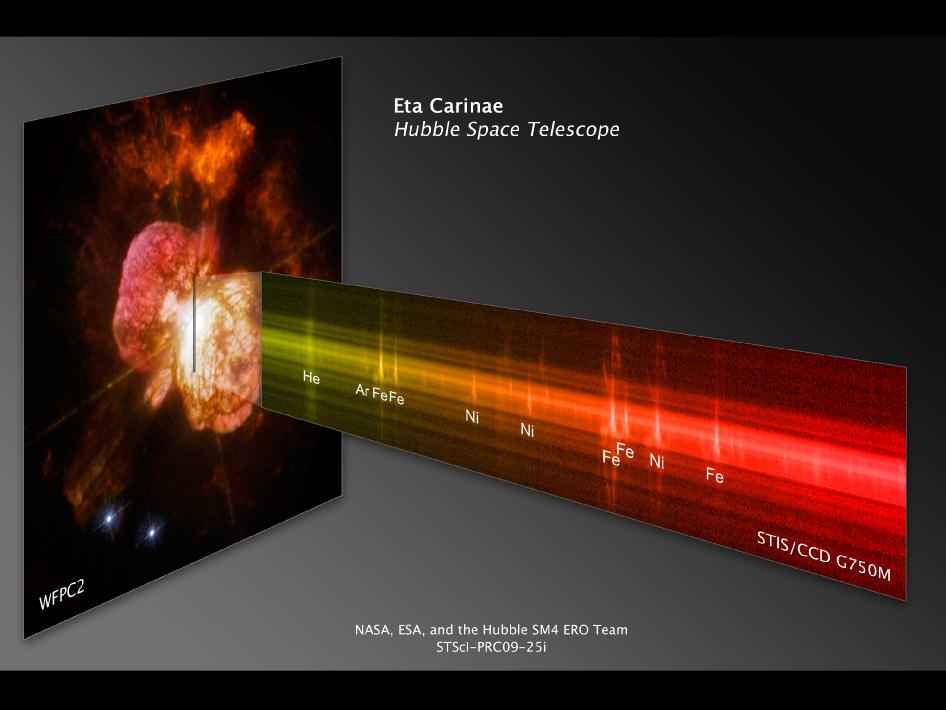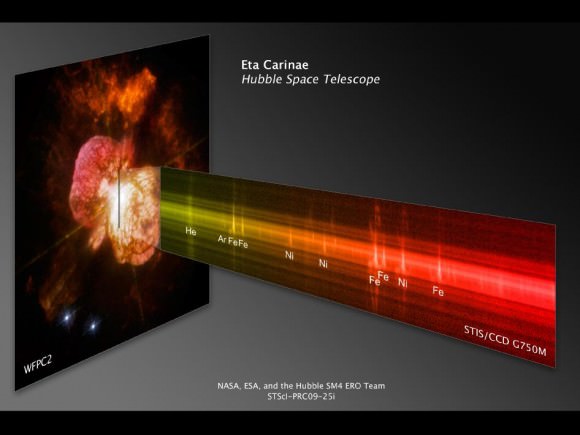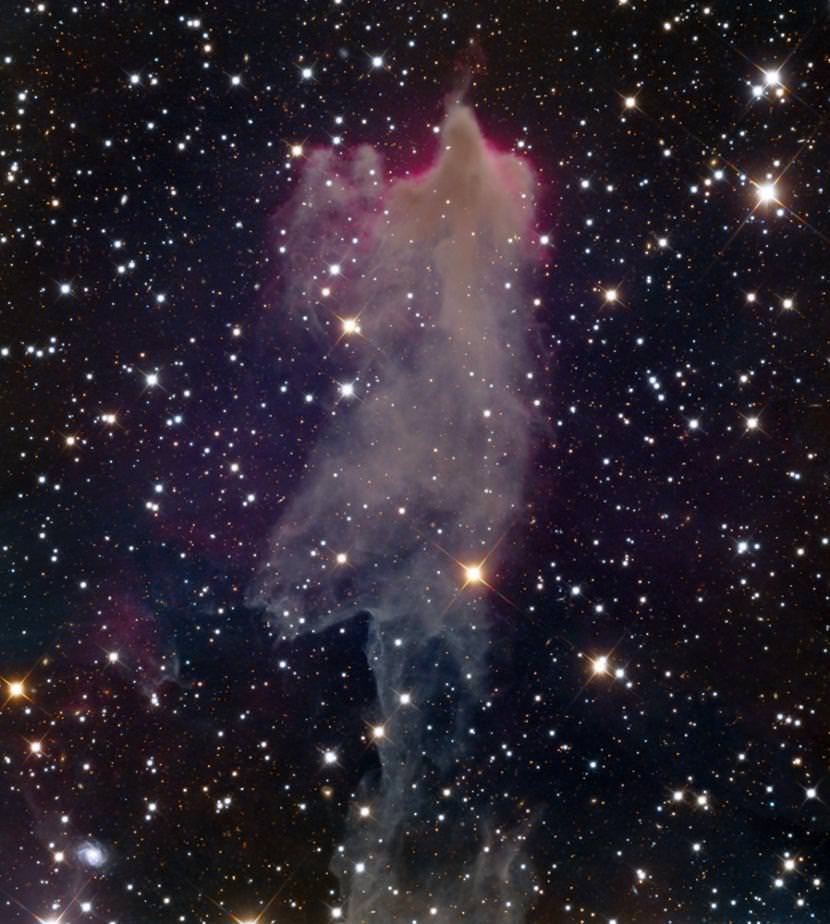For millennia, human beings have stared up at the night sky and stood in awe of the Milky Way. Today, stargazers and amateur astronomers continue in this tradition, knowing that what they are witnessing is in fact a collection of hundreds of millions of stars and dust clouds, not to mention billions of other worlds.
But one has to wonder, if we can see the glowing band of the Milky Way, why can’t we see what lies towards the center of our galaxy? Assuming we are looking in the right direction, shouldn’t we able to see that big, bright bulge of stars with the naked eye? You know the one I mean, it’s in all the pictures!
Unfortunately, in answering this question, a number of reality checks have to be made. When it is dark enough, and conditions are clear, the dusty ring of the Milky Way can certainly be discerned in the night sky. However, we can still only see about 6,000 light years into the disk with the naked eye, and relying on the visible spectrum. Here’s a rundown on why that is.
Size and Structure:
First of all, the sheer size of our galaxy is enough to boggle the mind. NASA estimates that the Milky Way is between 100,000 – 120,000 light-years in diameter – though some information suggests it may be as much as 150,000 – 180,000 light-years across. Since one light year is about 9.5 x 1012km, this makes the diameter of the Milky Way galaxy approximately 9.5 x 1017 – 1.14 x 1018 km in diameter.
To put that in layman’s terms, that 950 quadrillion (590 quadrillion miles) to 1.14 quintillion km (7oo septendecillion miles). The Milky Way is also estimated to contain 100–400 billion stars, (although that could be as high as one trillion), and may have as many as 100 billion planets.
At the center, measuring approx. 10,000 light-years in diameter, is the tightly-packed group of stars known as the “bulge”. At the very center of this bulge is an intense radio source, named Sagittarius A*, which is likely to be a supermassive black hole that contains 4.1 million times the mass of our Sun.
We, in our humble Solar System, are roughly 28,000 light years away from it. In short, this region is simply too far for us to see with the naked eye. However, there is more to it than just that…

Low Surface Brightness:
In addition to being a spiral barred galaxy, the Milky Way is what is known as a Low Surface Brightness (LSB) galaxy – a classification that refers to galaxies where their surface brightness is, when viewed from Earth, at least one magnitude lower than the ambient night sky. Essentially, this means that the sky needs to be darker than about 20.2 magnitude per square arcsecond in order for the Milky Way to be seen.
This makes the Milky Way difficult to see from any location on Earth where light pollution is common – such as urban or suburban locations – or when stray light from the Moon is a factor. But even when conditions are optimal, there still only so much we can see with the naked eye, for reasons that have much to do with everything that lies between us and the galactic core.
Dust and Gas:
Though it may not look like it to the casual observer, the Milky Way is full of dust and gas. This matter is known as as the interstellar medium, a disc that makes up a whopping 10-15% of the luminous/visible matter in our galaxy and fills the long spaces in between the stars. The thickness of the dust deflects visible light (as is explained here), leaving only infrared light to pass through the dust.
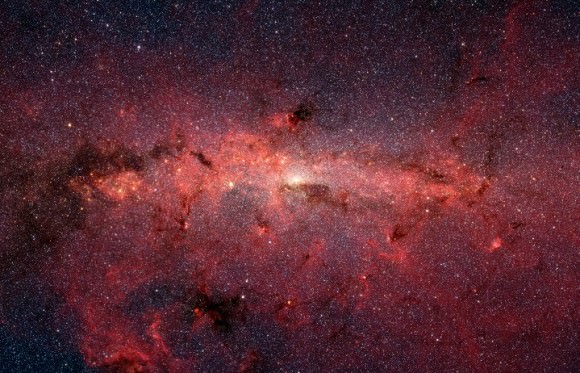
This makes infrared telescopes like the Spitzer Space Telescope extremely valuable tools in mapping and studying the galaxy, since it can peer through the dust and haze to give us extraordinarily clear views of what is going on at the heart of the galaxy and in star-forming regions. However, when looking in the visual spectrum, light from Earth, and the interference effect of dust and gas limit how far we can see.
Limited Instrumentation:
Astronomers have been staring up at the stars for thousands of years. However, it was only in comparatively recent times that they even knew what they were looking at. For instance, in his book Meteorologica, Aristotle (384–322 BC) wrote that the Greek philosophers Anaxagoras (ca. 500–428 BCE) and Democritus (460–370 BCE) had proposed that the Milky Way might consist of distant stars.
However, Aristotle himself believed the Milky Way was be caused by “the ignition of the fiery exhalation of some stars which were large, numerous and close together” and that these ignitions takes place in the upper part of the atmosphere. Like many of Aristotle’s theories, this would remain canon for western scholars until the 16th and 17th centuries, at which time, modern astronomy would begin to take root.
Meanwhile, in the Islamic world, many medieval scholars took a different view. For example, Persian astronomer Abu Rayhan al-Biruni (973–1048) proposed that the Milky Way is “a collection of countless fragments of the nature of nebulous stars”. Ibn Qayyim Al-Jawziyya (1292–1350) of Damascus similarly proposed that the Milky Way is “a myriad of tiny stars packed together in the sphere of the fixed stars” and that these stars are larger than planets.
Persian astronomer Nasir al-Din al-Tusi (1201–1274) also claimed in his book Tadhkira that: “The Milky Way, i.e. the Galaxy, is made up of a very large number of small, tightly clustered stars, which, on account of their concentration and smallness, seem to be cloudy patches. Because of this, it was likened to milk in color.”
Despite these theoretical breakthroughs, it was not until 1610, when Galileo Galilei turned his telescope towards the heavens, that proof existed to back up these claims. With the help of telescopes, astronomers realized for the first time that there were many, many more stars in the sky than the ones we can see, and that all of the ones that we can see are a part of the Milky Way.
Over a century later, William Herschel created the first theoretical diagram of what the Milky Way (1785) looked like. In it, he described the shape of the Milky Way as a large, cloud-like collection of stars, and claimed the Solar System was close to the center. Though erroneous, this was the first attempt at hypothesizing what our cosmic backyard looked like.
It was not until the 20th century that astronomers were able to get an accurate picture of what our Galaxy actually looks like. This began with astronomer Harlow Shapely measuring the distributions and locations of globular star clusters. From this, he determined that the center of the Milky Way was 28,000 light years from Earth, and that the center was a bulge, rather than a flat area.
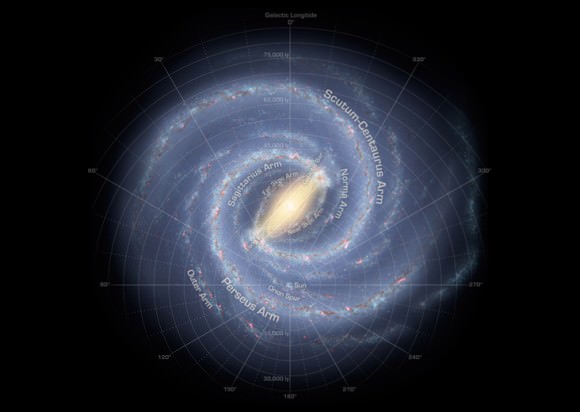
In 1923, astronomer Edwin Hubble used the largest telescope of his day at the Mt. Wilson Observatory near Pasadena, Calif., to observe galaxies beyond our own. By observing what spiral galaxies look like throughout the universe, astronomers and scientists were able to get an idea of what our own looks like.
Since that time, the ability to observe our galaxy through multiple wavelengths (i.e. radio waves, infrared, x-rays, gamma-rays) and not just the visible spectrum has helped us to get an even better picture. In addition, the development of space telescopes – such as Hubble, Spitzer, WISE, and Kepler – have been instrumental in allowing us to make observations that are not subject to interference from our atmosphere or meteorological conditions.
But despite our best efforts, we are still limited by a combination of perspective, size, and visibility barriers. So far, all pictures that depict our galaxy are either artist’s renditions or pictures of other spiral galaxies. Until quite recently in our history, it was very difficult for scientists to gauge what the Milky Way looks like, mainly because we’re embedded inside it.
To get an actual view of the Milky Way Galaxy, several things would need to happen. First, we would need a camera that worked in space that had a wide field of view (aka. Hubble, Spitzer, etc). Then we’d need to fly that camera to a spot that’s roughly 100,000 light years above the Milky Way and point it back at Earth. With our current propulsion technology, that would take 2.2 billion years to accomplish.
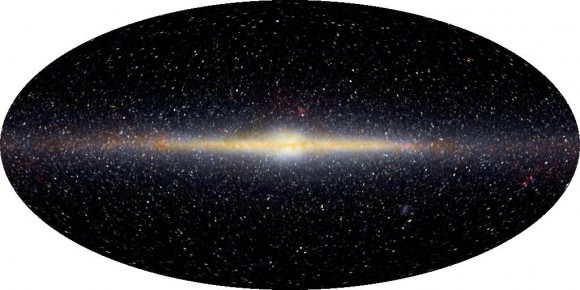
Fortunately, as noted already, astronomers have a few additional wavelengths they can use to see into the galaxy, and these are making much more of the galaxy visible. In addition to seeing more stars and more star clusters, we’re able to see more of the center of our Galaxy as well, which includes the supermassive black hole that has been theorized as existing there.
For some time, astronomers have had name for the region of sky that is obscured by the Milky Way – the “Zone of Avoidance“. Back in the days when astronomers could only make visual observations, the Zone of Avoidance took up about 20% of the night sky. But by observing in other wavelengths, like infrared, x-ray, gamma rays, and especially radio waves, astronomers can see all but about 10% of the sky. What’s on the other side of that 10% is mostly a mystery.
In short, progress is being made. But until such time that we can send a ship beyond our Galaxy that can take snapshots and beam them back to us, all within the space of our own lifetimes, we’ll be dependent on what we can observe from the inside.
We have many interesting articles on the Milky Way here at Universe Today. For example, here’s What is the Milky Way? And here’s an article on why it’s called The Milky Way, how big it is, why it rotates, and what the closest galaxy is to it.
And here are 10 Facts About the Milky Way. And be sure to check out our Guide to Space section on the Milky Way.
And be to sure to check out Universe Today’s interview with Dr. Andrea Ghez, Professor of Astronomy at UCLA, talking about what is at the center of our Galaxy.

